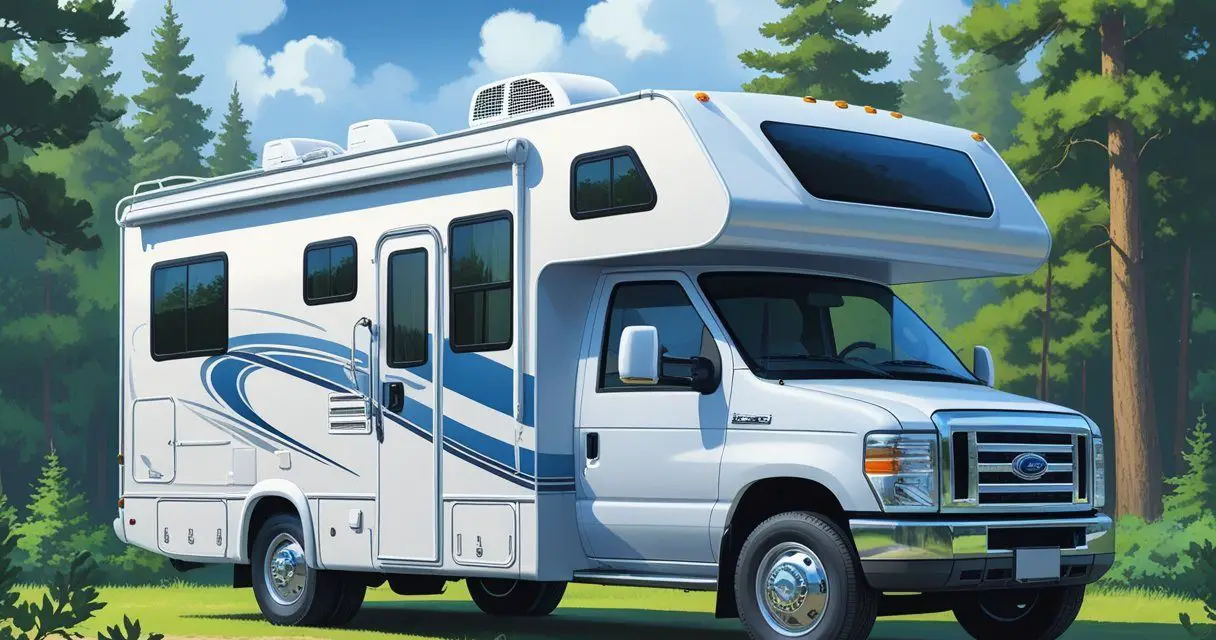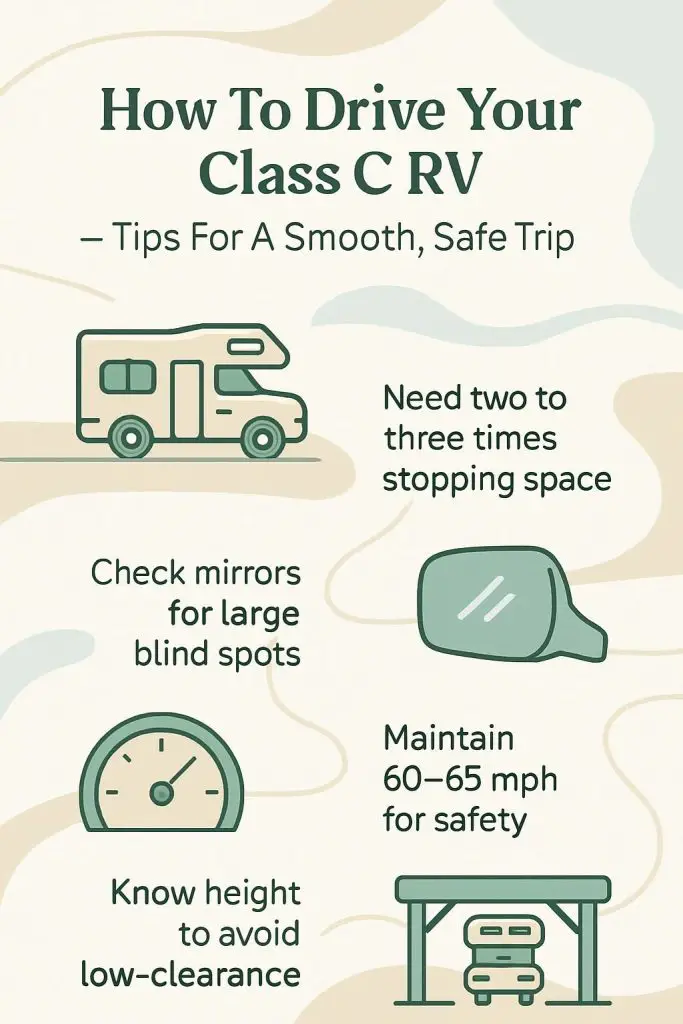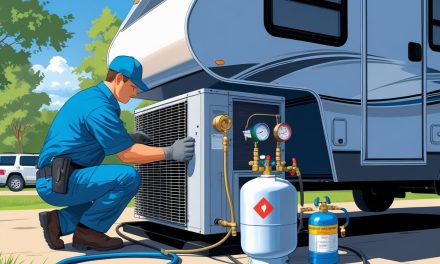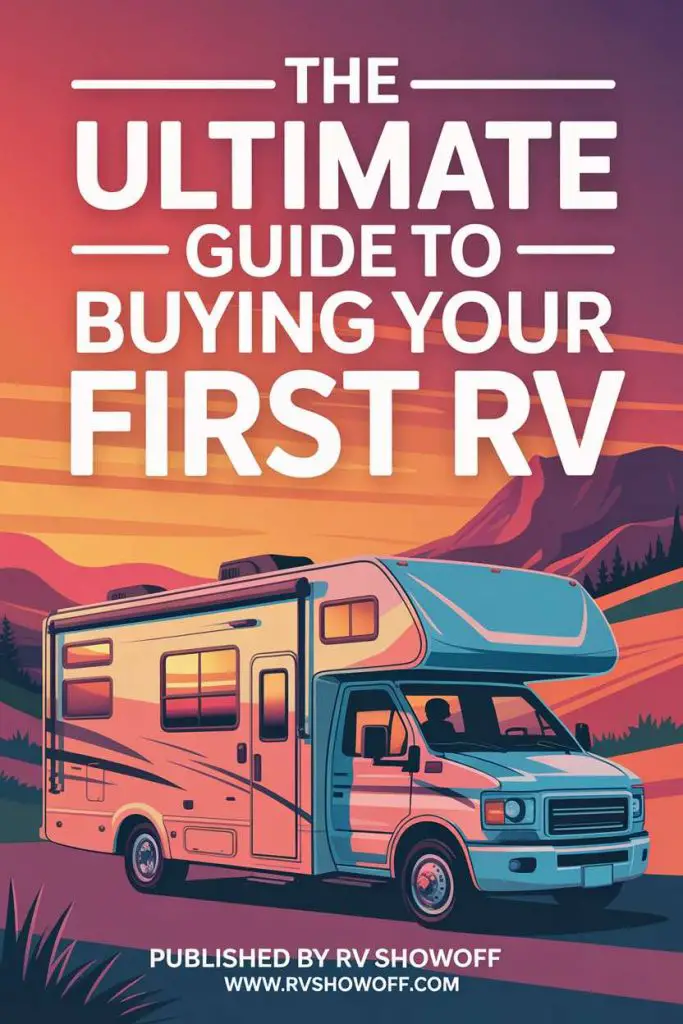Would you like to save this article?
Driving a Class C motorhome can feel tricky at first. You might worry about turning too tightly, missing a blind spot, or judging your stopping distance wrong. Many people face the same problems the first time they take their RV on a road trip.
These RVs are much larger and heavier than regular cars. That means you need to adjust how you drive for better safety and control. This guide will share simple tips on handling turns, using mirrors, checking your height, keeping up with maintenance, and driving safely in all kinds of weather.
You will learn what to watch out for and how small changes in habits can lead to smoother travels. Stick around for easy-to-follow advice that makes each mile less stressful!
Size and Handling Awareness
Driving a Class C RV is different from a regular car. You’ll need to be aware of its size and how it handles on the road.
Wider Turns
Cutting corners in a Class C RV can cause costly mistakes. Your vehicle’s rear wheels do not follow the same line as the front wheels during a turn. This is called “trailing” or “off-tracking.” Taking too sharp of a turn puts your rig at risk for hitting curbs, stop signs, bollards, and even gas pumps.
These accidents are common at gas stations where aisle width is much tighter.
Always swing out wider than you would with a car to give enough clearance for your longer vehicle dimensions. Bigger rigs need more space to navigate, especially around tight corners and crowded parking lots.
Traffic safety experts warn that taking turns too tightly increases collision risk with obstacles on the inside of your path.
Class C RVs must make wider turns to avoid running over curbs or striking fixed objects, says SafeTrek Training Group.
Slowing down before cornering gives you more control and time to judge how close you come to other vehicles or structures.
Increased Stopping Distance
Bigger RVs like your Class C need more space to stop. The weight and size raise your braking distance a lot compared to a car or SUV. Your stopping power depends not just on the brakes but also on how much you are carrying and how that weight is spread out in your vehicle.
Heavy loads plus full tanks mean even longer stopping times.
You must leave extra safety distance between you and traffic ahead, especially at highway speeds. It takes several seconds more for a loaded Class C RV to come to a complete stop from 55 mph than it does for most cars—sometimes two or three times as long.
Watch out for sudden slowdowns, keep alert, and always plan extra reaction time so you can avoid collisions before they happen.
Wider turns pose another big challenge after learning about stopping distances…
Longer Acceleration Time
A Class C RV needs more time to pick up speed than a regular car. The motorhome weighs much more, so the powertrain works harder during acceleration. Even with a strong engine, your RV is not built for racing or quick moves at lights and onramps.
Towing a trailer adds extra weight, making it even slower.
Do not expect to go faster than 65-70 miles per hour; going above this can cause poor handling and more wear on the engine and parts. Give yourself extra space when merging onto highways or passing other vehicles.
Watch your speed limit and plan each move carefully for better vehicle control and road safety. Taking it slow keeps you steady and protects both you and everyone else around you.
Larger Blind Spots
Longer acceleration time means you need to be extra careful. Larger blind spots can make driving trickier. Your RV has limited visibility to the sides and back, which increases the chances of missing vehicles or obstacles nearby.
Proper adjustment and use of side mirrors are key for better visibility. Always scan your mirrors while driving, especially in busy areas. This helps you stay aware of surrounding traffic and avoid accidents.
Keeping an eye on blind spots will boost your safety as you drive your Class C RV.
“Awareness is the key to safe driving.”
Driving Techniques
Driving your Class C RV can feel different. Keep speeds moderate to stay in control. Increase your following distance — this gives you more time to react. Practice U-turns in safe spaces before hitting the road.
Be aware of height limits, too; low bridges can surprise you. Want more tips? There’s plenty to discover!
Moderate Speeds
RVs are not built for high speeds. Going faster than 65-70 miles per hour can hurt your vehicle’s performance. It’s best to keep your speed around 60-65 miles per hour for better gas mileage.
This range helps improve fuel efficiency and engine performance. You’ll find you save on gas too.
Driving at moderate speeds also increases road safety. Slower speeds give you more time to react to sudden stops or changes in traffic. This is especially true on highways where larger vehicles like RVs take longer to slow down or speed up.
Keep this in mind as you drive, and adjust your pace accordingly, while being aware of the road ahead leads into techniques for maintaining a safe distance from other vehicles.
Increased Following Distance
To stay safe while driving your Class C RV, keep a greater distance from the vehicle in front. This distance matters because an RV’s stopping time is longer due to its weight. If you follow too closely, you increase the chance of a rear-end collision.
Defensive driving means anticipating what might happen on the road. It helps give you extra time to react if something unexpected occurs. A good rule is to maintain at least four seconds of space between your RV and the car ahead.
More space can make all the difference in ensuring a smooth trip!
U-turn Practice
U-turns can be tricky in a Class C RV. Practice makes perfect, and doing so helps with safety and confidence.
- Choose a wide space for practice. You need room to maneuver.
- Signal your turn early. This alerts other drivers about your move.
- Check your mirrors before starting. Look for blind spots behind you.
- Make the turn slowly and steadily. Quick movements can cause instability.
- Use backup cameras, but don’t rely on them alone. Always check around the RV for safety.
- Try practicing U-turns with a spotter. They can help guide you if needed.
- Plan your route ahead of time. Knowing where you can make turns helps reduce stress.
Practicing U-turns boosts your skills and keeps everyone safer on the road.
Height Awareness
Know the height of your RV. It is key for safety. Low branches, bridges, and overhead signs can cause damage if you aren’t careful. A collision with an obstruction can lead to expensive repairs, or even ruin your trip.
Check road signs for height restrictions on your route. Stay alert while driving; always scan ahead for potential hazards above you. Keeping a safe clearance will help prevent accidents and ensure a smooth journey in your Class C RV.
Pre-Trip Preparation
Pre-trip prep sets the stage for a great journey. Check your route and weather, keep an eye on your RV’s condition, and practice driving skills before you hit the road.
Route Research
Route research is key for a fun trip in your Class C RV. Start by checking the height of your vehicle. Low-clearance areas can ruin your journey if you’re not careful. Use navigation tools that show clearance heights.
This will help you avoid obstacles like bridges or overpasses.
Look at the roads you’ll take before hitting the road. Check for traffic updates and construction zones, too. Plan alternate routes just in case. Knowing what lies ahead keeps you safe and stress-free on your travels!
Weather and Road Conditions
After checking your route, focus on weather and road conditions. Winds over 5 miles per hour can sway your RV. If winds become extreme, this could lead to a loss of control or even tipping.
It is crucial to slow down in windy weather; sometimes lowering your speed to as low as 35 miles per hour on highways helps keep you safe.
Check traffic conditions too. Heavy rain or snow can make driving difficult. Road safety should always be a top priority during your trip planning. Be ready for changes in weather and adjust your driving speed accordingly, because safety is key!
RV Maintenance
Check your RV before hitting the road. Make sure all systems are working well. This includes electrical systems and stability control features. Keep an eye on the stabil track sensors too.
High winds can cause these sensors to activate, which might disable cruise control. To reset it, simply turn off your RV, take out the key, then put it back in and start it again.
Inspect weight distribution as well. It impacts how smoothly your RV drives. Loading items evenly keeps handling stable while driving. Always have a predeparture checklist ready for these maintenance checks.
It helps you stay organized and travel safely.
Practice maneuvers for confident driving next…
Weight Distribution
Weight distribution is key for safe driving in a Class C RV. Balanced loading helps with vehicle stability and improves fuel efficiency. When you load your RV, make sure all cargo is well-placed.
Aim to keep heavier items low and close to the center of the vehicle.
Check the weight on each axle during your trip preparation. This helps prevent transportation safety issues that can arise from uneven loads. Proper weight management keeps your ride smooth and reduces strain on your brakes and tires too.
Pay attention to these details; they make a big difference in how well you drive!
Practice Maneuvers
Practice makes perfect, especially when driving a Class C RV. Getting comfortable behind the wheel is key for safety.
- Adjust your mirrors for better visibility. Some RVs have power mirrors, while others need manual adjustments. This helps reduce blind spots and improves lane awareness.
- Practice turning in an empty parking lot. Start with wide turns to get used to the size of your vehicle. This will help you avoid hitting curbs or other obstacles.
- Work on U-turns in open spaces. They require more room than smaller cars. Practicing will boost your confidence when you need to make tight turns on the road.
- Try stopping from different speeds. The stopping distance can be much longer for an RV compared to regular vehicles. Understanding this lets you plan stops better.
- Test out acceleration time in safe areas. It takes longer for an RV to reach full speed, so give yourself extra time when merging into traffic.
- Make sure everyone knows where to sit during practice drives. Passengers should stay seated and use their seatbelts at all times for added safety.
Practicing these maneuvers will help you feel ready and confident before hitting the road… Safety always comes first! Now let’s move on to Pre-Trip Preparation.
On the Road
Stay alert as you drive your Class C RV. Keep a safe distance from other cars, and always watch for changing road conditions.
Proactive Driving
Proactive driving means being aware of everything around you. Look at your mirrors often. Check the road and traffic conditions ahead, especially in busy areas. This habit helps avoid accidents by spotting potential hazards early.
Always stay alert. Understand that your RV has bigger blind spots compared to regular cars. Scan for pedestrians, cyclists, and other vehicles. Pay attention to changing traffic patterns as well.
This awareness allows you to react quickly and keep everyone safe on the road.
Right Lane Position
Stay in the right lane as much as you can. This helps keep your Class C RV steady, especially on busy roads. Larger vehicles like semis can create strong wind gusts when they pass.
These winds affect your RV’s stability and aerodynamics.
Avoid staying in the left lane unless you are passing another vehicle. You’ll have better control and maneuverability in the right lane. Plus, this position allows other drivers to see your trajectory more easily.
Use this space to stay safe and drive calmly on the road. Next up is taking regular breaks!
Regular Breaks
Regular breaks are key for driver alertness. They also help you check your RV for any issues.
- Take a break every two hours or so. This helps keep you alert.
- Use rest stops to relax and stretch your legs. Movement can reduce fatigue.
- Check your vehicle during each stop. Look for height-related damages or aerodynamic problems.
- Stay hydrated while driving. Drink water at each break to stay sharp.
- Have a snack if you’re feeling low on energy. Small meals can boost your focus.
- Talk with travel companions during breaks. Sharing thoughts keeps the mood light and fun.
- Adjust your seat and mirrors when you stop. Getting comfortable can make a big difference when driving again.
- Avoid long stretches without stopping. This is crucial for safe driving in an RV.
These simple steps can make your road trip smoother and safer!
Effective Communication
Clear communication is key for a safe RV trip. Talk to your passengers and co-drivers often. Make sure everyone knows about the RV’s handling limitations and safety rules. Use simple instructions.
Ask questions to confirm that everyone understands.
Stay engaged with your group as you drive. Share what’s happening on the road, like obstacles or turns ahead. This helps build teamwork and awareness among all who are in the vehicle.
Good coordination can prevent accidents and keep everyone safe during your journey.
Conclusion
Driving a Class C RV can be a fun adventure. Just keep in mind, it’s larger and heavier than your car. Exercise extra caution with turns and stopping distances. Stay aware of height and gas station hazards too.
Follow these tips for a smooth, safe trip on the open road!







